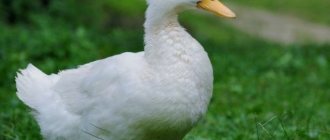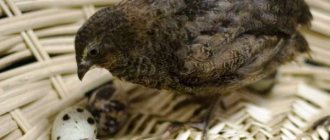Does an ostrich hide its head in the sand?
These birds are the largest of the flightless birds and still survive in the wild. Their behavior has interested people since ancient times, and the sight of a bird with its head down impressed many.
Did you know? The remains of products made from ostrich shells were found in the Altai cave, where people lived 50 thousand years ago.
The common expression “an ostrich buries its head in the sand” implies that, when very frightened, the bird considers it sufficient to hide only its head. This version is still popular in many countries.
In fact, the bird can be caught with its neck bowed, but it does this for other reasons.
A bird will reject its chicks if they are touched by a person
Photo: bereta/Depositphotos Surely you know that if you pick up a chick that has fallen from the nest and put it back, the bird will abandon the clutch.
Because the nest now smells like a person. It sounds creepy, of course, but don't worry. Birds simply cannot Fact or Fiction?: Birds (and Other Critters) Abandon Their Young at the Slightest Human Touch smell a person. According to Do Birds Really Abandon Their Chicks If Humans Touch Them? Mieko Chu, a specialist at the Cornell Laboratory of Ornithology, their sense of smell is not sufficiently developed for this.
So if you return the chick to the nest, the parents will most likely continue to care for it as if nothing had happened.
Why do they hide
If an ostrich lowers its head low, this does not mean at all that it buried or hid it. There are several explanations and possible reasons why he does this.
Search for food
Ostriches feed on plant foods and also happily eat small insects, lizards and rodents. At first, parents give the chicks only food of animal origin. Such food must be crushed, and birds do not have teeth.
They search for and swallow various objects:
- pebbles and small stones;
- pieces of wood;
- in captivity they can eat nails and pieces of plastic.
It is at the moment of searching for and swallowing such stones that the bird stands, bending low to the ground.
Bird's Dream
Ostriches are social animals and do not live alone in nature. Always on guard, they sleep in turns and protect each other's sleep. A sleepy bird bends its legs and sits on the ground, bowing its head or hiding it under its wing. Sometimes in her sleep she continues to hold her neck upright and only closes her eyes, ready to immediately run away at the slightest sign of danger.
From fear and for protection
An ostrich sitting on her eggs in a nest, in a dangerous situation, tries to merge with the surrounding landscape and spreads her wings, neck and head on the ground. In a normal situation, a frightened bird will quickly run away from its pursuer, but maternal instinct encourages it to stay in place, protecting the clutch.
Also, lowering the neck and head, along with spreading the wings, is a characteristic part of courtship dances and is demonstrated by the female in response to the courtship of the male.
Looking for food
It is believed that by burying itself in the sand, the bird searches for insects. But why would an ostrich do this if insects can be found on the surface? The correct answer is this: to collect bugs from the surface, a tall bird bends low, looks for food and eats it. Therefore, from the outside it seems as if the head of an adult is in the sand.
Basically, the bird prefers plant birds - its long neck allows it to get tasty fruits, dig up roots, and pluck green grass. The ostrich tilts its head to find food of plant and animal origin, collect pebbles for good digestion, or dig a hole in which the offspring will hatch. The latter process requires a lot of time and effort, since the female’s eggs are huge, and she can carry them for a long time.
How ostriches really behave
These feathered giants live in hot savannas next to antelopes, giraffes and other herbivores. Traveling together across the plains, they are the first to react to the appearance of predators due to their excellent vision, hearing and tall stature. When fleeing from danger, their speed can increase to 70 km/h. Only after an exhausting long run can an ostrich lower its neck, which is evidence of a complete loss of strength.
During the breeding season, birds become aggressive and find another use for their strong limbs. Protecting their offspring, they strike with muscular legs with sharp claws. They are quite capable of injuring or killing even a large predator.
Important! Contrary to popular belief about the extreme timidity of these birds and their inability to actively resist, an ostrich can attack a person in defense of its nest or territory.
So, the question of whether ostriches stick their heads in the sand when scared has long had a clear answer. Bird behavior studied in the wild and in captivity clearly shows that this is just an ancient misconception.
Interesting Facts
- It is believed that the size of the ostrich's brain (40-60 g) is smaller than its eye. In reality, this statement is not entirely true, since the bird's eyes are very large. Therefore, the size of the brain can be compared with a pair of eyes, which will have a larger volume in relation to the brain.
- The ostrich has two toes on each paw, which allows it to develop very high speed when moving. One of the fingers has a special hoof on which it rests while running.
- During the breeding season, the dominant male mates with all the females of the flock and, for subsequent incubation of the chicks, digs a nest - a hole up to 30-60 cm deep. Females periodically lay their eggs in a common nest, which are subsequently hatched together. During the day they are on duty on the clutch, and at night they are replaced by a male.
- The largest egg in the feathered world belongs to the ostrich, its size ranges from 15 to 21 cm in length and 13 cm in width, its weight reaches 1.5-2 kg, which corresponds to 25-35 chicken eggs.
- Ostrich chicks are born already fully developed and move well, their weight reaches 1.2-1.5 kg, and within six months they grow to human height.
- Birds have long been used as a means of transportation for riding or harnessing.
- In the middle of the 19th century, farms for breeding and keeping ostriches appeared, which contributed to the preservation of the population of the species. Currently, these birds are bred in more than 50 countries, including our country.
Attention, TODAY only!
Lifestyle and nutrition
Why don't ostriches fly? Flight requires a huge amount of energy. There are no biological processes that could provide the necessary energy to a heavy body. At least in the current state of the biosphere.
The time of giant flying lizards has passed with a decrease in the amount of oxygen in the atmosphere. And they were never gigantic. The effect of a large creature was created by long, sweeping wings. And the bodies of flying birds and mammals, and even earlier, reptiles, were never as large as those of ostriches.
But these birds run beautifully. Along with cheetahs and many ungulates, they are leaders among runners in open spaces.
Ostriches eat:
- plants - mostly young sprouts;
- insects;
- worms;
- grains;
- fruit.
Since their diet is dominated by hard grains, to grind such food into their crops they need stones that can be pecked from the ground.
It is believed that ostriches live in the desert. Many people associate this concept with dunes, that is, constantly moving sand. But ostriches do not live in the sand. There is nothing for them to eat there. If we talk about the desert, then they live more in a semi-desert, that is, where there is grass, insects, stones and usually hard ground on which to run.
Thus, the birds in question live on solid ground, and not on loose sand.
Looking for food
It is believed that by burying itself in the sand, the bird searches for insects. But why would an ostrich do this if insects can be found on the surface? The correct answer is this: to collect bugs from the surface, a tall bird bends low, looks for food and eats it. Therefore, from the outside it seems as if the head of an adult is in the sand.
Basically, the bird prefers plant birds - its long neck allows it to get tasty fruits, dig up roots, and pluck green grass. The ostrich tilts its head to find food of plant and animal origin, collect pebbles for good digestion, or dig a hole in which the offspring will hatch. The latter process requires a lot of time and effort, since the female’s eggs are huge, and she can carry them for a long time.
Popular myths and their refutation
The myth, which has existed for a long time and is still popular, has quite plausible interpretations. However, in fact, all of them are easily refuted.
Fear
It is generally accepted that this bird, greatly frightened, hides its head in the sand - apparently hoping that its body will not be visible on the surface. In fact, the female sitting on the eggs, noticing the predator, tries to become as invisible to him as possible.
The female bends down to the ground with her whole body, pressing her neck and head, which can be misinterpreted from a distance. If this does not work, the bird will lead the predator away from the nest or protect it. It should be noted that a blow with a two-fingered clawed paw can be extremely dangerous for a lion.
Important! Recommendation for ostrich breeders: with a blow of its paw, a bird can bend a metal rod one centimeter thick, so it must be handled with care, especially during the breeding season. To further debunk the myth, let’s remember the speed of up to 70 km/h that these giants can reach if they are in danger
. To further debunk the myth, let's remember the speed of up to 70 km/h that these giants can reach if they are in danger.
To further debunk the myth, let's remember the speed of up to 70 km/h that these giants can reach if they are in danger.
Dream
The assumption that ostriches sleep with their heads buried in the sand is also untrue. Ostriches are social birds: they live in groups and have a clear range of responsibilities and rules.
We recommend reading about how to collect and store ostrich eggs before incubation, how to incubate ostrich eggs at home, and also how to make an incubator for ostrich eggs with your own hands.
For example, birds take turns sleeping, sitting down on their long legs and hiding their heads under their wings, as many birds do. But the “guards” who are awake at this time tilt their heads to the ground from time to time in order to hear the approaching danger in time. This could also be a source of confusion.
Finding food underground
The diet of ostriches includes roots, leaves, seeds and herbs, and in addition to them - insects and small reptiles. To pick something up from the ground, having such a height, you have to bend low.
A head lowered into a thicket of grass or bushes for a few minutes may well lead to the wrong thoughts. In addition, due to their special digestive system, ostriches need to regularly fill their stomach with pebbles, which help grind food.
Important! Recommendation for novice farmers: in a pen or ostrich flock there should always be a container with coarse sand and small pebbles or gravel. Let's summarize: as the facts prove, the bird does not hide its head in the sand, if only because it can suffocate
There are reasons that force these giants to bend low, even tearing the sand with their beaks, but in this ostriches are no different from the most ordinary birds
Let's summarize: as facts prove, a bird does not hide its head in the sand, if only because it can suffocate. There are reasons that force these giants to bend low, even tearing the sand with their beaks, but in this ostriches are no different from the most ordinary birds.
Real reasons
Since the misconception was based on the fact that in this way the ostrich is trying to hide from predatory animals, ornithologists were able to prove that in the event of a real threat, the bird simply runs away, and it can run at enormous speeds, reaching up to 80 km/h. At the same time, ostrich running differs from the running of all other living creatures in that the runner can abruptly change the direction of movement, literally instantly. However, after running to the point of exhaustion, the bird becomes so tired that it falls exhausted to the ground, and it can actually end up in the sand with its head simply for the reason that there will be sand under its feet at that moment, and not solid soil.
In addition, while incubating eggs, females are forced to spread out on the ground, stretching out their necks and pressing their heads to the ground in order to become less noticeable to approaching enemies, and during sleep their heads also lie on the surface of the ground.
Interesting facts about ostrich speed
By the way, when a bird picks up food from the ground, only one of its tail sticks out from the tall grass, which can also give rise to a misinterpretation of this behavior by the observer. And in addition to food, ostriches pick up small pebbles from the ground, which they need for proper digestion.
Who came up with this joke?
During the times of the Roman Empire, the scientist Pliny the Elder claimed that ostriches, when frightened, stick their heads into the sand with lightning speed. At this moment, Pliny believed, they think that no one sees them.
In past times, there were scientists who claimed that the Earth was flat and stood on three pillars. Moreover, those scientists absolutely seriously believed in this. But the further development of science and education, numerous studies, have led to the fact that today every first-grader knows: the Earth is round and revolves around the Sun.
Of course, the ancient Roman scientist did not think to joke, but modern biologists believe that ostriches never do that.
The expression “hiding your head in the sand” remains an apt joke referring to those who do not want to solve their problems, but only hide from them and try not to notice.











